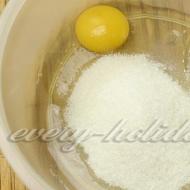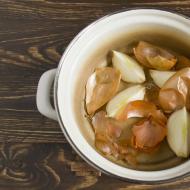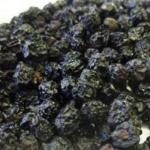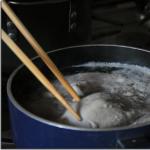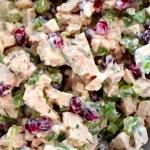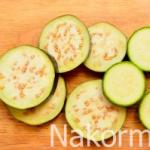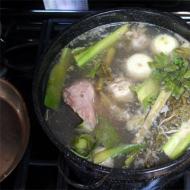
Seaweed rolls. How to cook delicious rolls at home. What are rolls, what products are needed for their preparation
Cooking rolls at home
How to cook rolls at home, step by step recipe with photo. homemade rolls- cooking secrets .Preparation of rolls. Rice for rollo in how wrap rolls. How to do homemade rolls. Rolls at home photo conditions. How cook rice for rolls. How to store nori seaweed.
By popular demand, I post a short step-by-step photo recipe for making rolls at home. I want to say that making rolls at home- it's easy, tasty and fast. After I started doing rolls at home On my own, I stopped going to those Japanese eateries. Why pay 200-300 rubles for something that I can do without much work at home. I will give you some tips and advice. It takes me a little over an hour to cook 12-15 servings of rolls, and this is along with cooking rice. Cooking rolls at home - for me - is much easier than, for example, cooking shawarma at home.
What you need to buy to make rolls:
- Rice for sushi.
- Pressed seaweed nori for wrapping rolls.
- Rice vinegar.

There is no need to save on rice and algae - this is the basis. I always buy Blu Dragon rice, it is quite common in many chain stores. Do not buy nori sheets in excess, nori does not store well after opening. If you still have nori sheets, then store them in an airtight package or a plastic bag in a dry, dark place. Nori does not tolerate moisture. Poor-quality nori can be badly chewed.
Many ingredients can be used for the filling, in this recipe we used:
- Trout lightly salted own salting.
- Crab sticks
- Avocado
- Cucumber
- Philadelphia cheese

We didn't make it too hard rolls cooked in the first recipe and cook only rolls wrapped in nori sheets. In the following recipes, we will talk about cooking more complex rolls, such as, philadelphia roll and etc. Salted trout we do it ourselves. I just like avocados, and crab sticks and cucumbers were in the refrigerator. I definitely recommend adding Philadelphia cheese to the rolls, it gives a delicate taste to the roll. When it comes to stuffing for rolls, then you can experiment to your liking.
Of course, you can order free delivery of rolls in Moscow, but for me, hand-made rolls are tastier. And I am always confident in the quality of the products.
What else you need to buy for the rolls:
- Japanese horseradish wasabi
- pickled ginger
- Soy sauce.
- Chuka seaweed salad

The list is endless: sake, Japanese beer, etc. But wasabi, ginger and soy sauce are a must. If you take kikkoman soy sauce, then take the sauce with a green cap - it is less salty than the one in the photo with a red cap.
We also cannot do without a bamboo mat. It is needed for wrapping a roll into a roll.

Let's get to the main point - cook rice for rolls.

I cook 500 grams of rice - this amount makes 12-15 servings of rolls. If you need less, reduce the amount of rice, water and vinegar proportionally.
Put rice for rolls in a colander and rinse under running cold water.


We spread the rice in a saucepan, fill it with cold water and set aside for 20 minutes. After twenty minutes, drain the water.

Add water to the rice at a ratio of one cup of rice to two cups of water. We put it on the stove, wait for it to boil, reduce the heat and cook rice for rolls until ready.

We are filming rice for rolls from the stove and remove to reach a warm place (under the pillow).

While the rice is cooking, we are preparing stuffing for rolls. You need to cut everything into thin strips.


Cut into strips trout and crab sticks.



Peel the cucumber and avocado and also cut into strips.

Now we need to finish the rice for the rolls. Pour 4 tablespoons of rice vinegar into a small ladle (this is for 500 grams of raw rice) pour four tablespoons of sugar into the vinegar. We put the ladle on the fire and, stirring constantly, dissolve the sugar in the rice vinegar.

Let's prepare a tray, in such a tray it is convenient to mix rice with vinegar. We will also need a spatula.

Spread the rice into the tray in an even layer.


Water evenly rice for rolls with vinegar and sugar and mix the rice with cutting movements of the spatula. We do not interfere with rice in the literal sense of the word, but, as it were, cut it with a spatula.

We are ready for the wrapping process rolls. Rice should be at human body temperature.

We take out a sheet of nori. One side of the nori sheet is glossy and the other side is rough. Lay the sheet glossy side down. There is also a corrugation on the nori sheet, in one direction - frequent, in the second - rare. Sparse corrugation allows us to spread rice on a nori sheet in the same way on all sheets and make the same rolls. You can make smaller rolls, then the nori sheet needs to be cut in half along the central corrugation line.

Lay the sheet glossy side down. There is also a corrugation on the nori sheet, in one direction - frequent, in the second - rare. Sparse corrugation allows us to spread rice on a nori sheet in the same way on all sheets and make the same rolls. Can do rolls smaller, then the nori sheet must be cut in half along the central corrugation line.

We put a container with warm water next to us and begin to distribute the rice over the nori sheet. Don't put too much rice in rolle there will be a lot of rice and little toppings. The layer of rice should be thin.

On the one hand, rice should cover the sheet to the edge of the nori sheet, on the other hand, leave part of the nori sheet free.



Put the stuffing and a little Philadelphia on the rice. We put the filling in various combinations, then decide for yourself which one you like best.

Let's start wrapping roll. Moisten the part of the nori that is free from rice with water. We bend the mat and little by little, crushing the rice with the filling, wrap the roll.

After wrapping, add roll shape and set aside on a plate. Let's move on to the next roll.

Cool rolls until all the rice is used up.

Now you need to carefully cut rolls. We take the sharpest knife. I recommend that you first cut the roll in half, and then cut the halves into three equal parts.

Cut into portioned pieces roll put on a plate or dish. Decorate with chukka and ginger and serve the rolls on the table.

Do not cut all rolls at once. not cut rolls cover with cling film and put in the refrigerator. Rolls stored in the refrigerator for several days, almost without losing taste.
The Japanese sushi dish has long been included in the menu of the townsfolk and has ceased to be an overseas curiosity of raw fish. Sushi is distinguished by a wide and varied assortment, they come with the most amazing toppings and are served in almost every self-respecting institution. Sushi has firmly taken its place in the list of preferred dishes.
How to cook rice for sushi?
Many people have decided to go further than just wandering from restaurant to restaurant comparing sushi from different chefs. Some especially gambling enthusiasts try to cook sushi at home, bringing some new ingredients and fresh solutions to them. Although sushi is not an easy dish to make, it is quite possible to make it at home.The main and indispensable ingredient is, of course, rice. It is rice, not fish, that is the main component of sushi. If you can experiment with fillings, then sushi will not work without rice. Rice must be round grain or special for sushi so that it holds its shape.
Two servings require one glass of rice. After pouring the rice into a deep container, fill the cereal with cold water and rub it between your palms. Then drain the water. Repeat a few more times until the water is as clear as possible. This is necessary so that the cereal is cleansed of excess gluten and starch. They are completely unacceptable when preparing sushi. Let the rice dry out a bit.
Dip the rice in a deep saucepan and fill with a volume of water twice the volume of cereals. Put it on maximum heat and bring it to a boil under the lid. After boiling, reduce the heat to a minimum, cover with a lid and cook for 12 minutes. Then, without removing the lid, remove from heat and let it brew for another 15 minutes.
How to cook rice for sushi and rolls
Prepare the rice dressing. To do this, in 25 ml of rice vinegar (if you took a glass of rice), you need to dissolve 5 grams of salt and 15 grams of sugar. Mix everything until completely dissolved. To make this process faster, you can warm up the vinegar a little, but only a little.
Add dressing to rice. To do this, lay the rice in an even layer in a dish with a flat bottom. Pour the dressing over the spatula into the rice, the trickle should be thin. Stir the mixture thoroughly immediately. Mix from bottom to top and from left to right. Then, having collected the rice in one direction, begin to drag it to the other side with sharp smearing movements with a spatula (without stirring!). Repeat the procedure several times. Then flatten the rice and cover with a damp cloth. Then leave it to cool down.
Ingredients for making sushi at home
To make sushi at home, you need to purchase the following ingredients: 
- seaweed "nori" - they are sold in different sizes, for sushi - in small plates, for rolls - twice as much (the price depends on the quantity)
- package of pickled ginger and wasabi (Japanese horseradish), it is better to take wasabi in powder - so it will be spicier
- soy sauce (distinguished by the degree of salinity)
- rice vinegar, designed specifically for making sushi (it is slightly sweet and gives the dish a special aroma and exquisite taste)
- rice (either special or regular, uncooked, round grain rice)
- salmon fillet (salted or smoked), mackerel fillet (mackerel may also work), ready-made shrimp or any other seafood for stuffing
- Philadelphia cheese (or any cream cheese without additional additives)
- fresh cucumber
- flying fish roe (this component is optional and is optional, you can do without it)
- sesame seeds (roasted or raw)
- avocado
- bamboo mat
How to cook rolls?
In addition to rice, there is another important point in the preparation of sushi and rolls - they must be twisted. Otherwise, we will have rice with fish, not sushi. Seafood with cucumber and avocado is also used as a filling.This is easier to do with a special bamboo "mat". Place a sheet of special nori seaweed on it, rough side up, on which the filling holds better. Put the cooled rice on the nori, 0.7-1 centimeter thick, spread it evenly over the surface. Leave 1 and 0.5 cm of clear space at the top and bottom of the sheet, respectively. This is necessary to secure the roll.
How to quickly make sushi at home
Prepare the filling in advance - cut the desired ingredients with elongated sticks, 3-5 mm thick. Put the stuffing on the rice and start rolling the roll, which will later turn into sushi. Gently lift the end of the nori with a bamboo mat (makisu) and slowly roll it into a tight tube. Gently squeeze the roll inside the mat and roll it around a bit.
For better adhesion of nori into a roll, you can soak the seaweed in the place where there is no rice and combine with the roll. Pushing the finished roll aside, proceed to the manufacture of the next portion.
If, nevertheless, this task seems unattainable for you, you can always use the services of companies that provide sushi orders at home.
How to cut the rolls correctly?
To properly cut the rolls, take a sharp knife. Dip its tip briefly in vinegar water. Then you should raise it with the tip up so that the vinegar water wets the entire surface of the knife. Then it will be easy to cut the rolls. 
Then place the rolls seam side down on a cutting board. First, you should cut the resulting roll in half, and each half into three more. The knife can be periodically soaked in water, either vinegar or just cold, to remove the sticky component of the rice.
How to make rolls: a master class from the chef
Then put the rolls on a tray, pour soy sauce into ceramic bowls and serve.
What is the best sushi?
Sushi, as mentioned above, can be very diverse. Therefore, the choice of the most delicious remains, of course, yours. But the most popular, according to the editors of the site, have always been and remain Philadelphia and California rolls, as well as sushi with eel, salmon and mussels.Roll "Philadelphia"
Cooking sushi "nigiri"
While the sushi rice is cooling, you need to cut the fish. It is better to choose the cleanest and most beautiful part of the fillet. The denser it is, the thinner the pieces should be. For nigiri, it is better to cut the fillet at an angle towards you. In order not to have to “cut” the fish (which is unacceptable for sushi), pick up a very sharp knife.Stepping back from the edge of a rectangular piece of fillet by 1-1.5 cm, cut off a piece of fillet at an angle of 45 degrees in one motion. Thus, cut the whole fillet.

We begin to form nigiri. To do this, prepare a container with wasabi and vinegar water (pour a couple of tablespoons of rice vinegar into boiled water). Put about one and a half tablespoons of cooked rice in your right hand and give it an oval shape. In the left, put a plate of fish fillet across the fingers. Without releasing the rice, scoop up some wasabi and brush over the rice. Put rice on it and lightly press it with the thumb of your left hand.
Then change hands and press the rice with the index and thumb of the right hand. Gently turn the nigiri over on the fingertips of your left hand, fish side up. Then move them to the base of the fingers. Ready!
It is only important to ensure that the fish preparation is larger than the rice, and that the rice is not compressed too much.
Subscribe to our channel in Yandex.Zen
The boom and special surge of fashion for sushi seems to have already been left behind, however, having lost casual fellow travelers, rolls have taken a strong position on the tables of those who actually fell in love with this light and very healthy food.
At the same time, many roll lovers still refuse to master the art of making sushi at home, believing that it is difficult, energy-intensive and very expensive. This master class is just for those who are afraid and in doubt: I hasten to prove that rolls at home can be simple and inexpensive.
Please note that this is not a sushi making class for professional chefs. I offer an adapted version of rolls that are tasty, healthy and easy to prepare. In addition, all the basic ingredients can be found in the nearest supermarket and do not puzzle over where to buy the mysterious sushi vinegar and how to replace the rare rice for rolls. So, if you are ready, I ask you to the kitchen, we will cook sushi at home!
Ingredients
- 3 small cups of rice;
- 4 small cups of water;
- 3 art. l. Sahara;
- 1 tsp salt;
- 2 tbsp. l. table vinegar;
- 200 g lightly salted salmon;
- 2 cucumbers;
- 8-10 nori sheets;
- 200 g melted cheese.
Cooking
Large photos Small photos
First, Fig. I do not buy special sushi cereals, which are unreasonably expensive in our reality, I get by with the most ordinary round rice, which is found in any store. Moreover, I am sure that even in specialized restaurants in my city they prepare sushi from the same rice that I buy. The secret of stickiness is not at all in the variety, although, probably, in it too. The secret is in the right cooking technology: a little experience, and you will be no worse than a professional sushi maker.
So, we take three cups of round rice (I specially got up and checked the volume of the cup that I use - 160 ml, it is convenient for me, therefore I give the number of ingredients for it; if you have other volumes, just proportionally change the rest of the components) and rinse well with running water. Fill with four cups of water and put on fire. Bring to a boil, close the lid and reduce the gas to a minimum. Without lifting the lid, cook for 15 minutes. It may take a little less or a little more time - listen to rice: as soon as the nature of the sound of boiling water changes and you realize that all the liquid has “left”, immediately turn it off, but do not hold it for more than the specified time. Note the time - the next 10 minutes do not touch the rice.

While the cereal is resting, prepare sushi vinegar. Again, you can buy it in specialized stores, or you can cook it yourself. Of course, in the original it should be a special rice vinegar, however, we are talking about an adapted version of the rolls, so I still recommend not to lose your head, not to waste money and make do with what is at hand.
Mix sugar and salt and pour half a cup of boiling water over them. Stir until smooth and leave to cool. Add vinegar after 10 minutes.

Let's go back to rice. Open the lid, pour the vinegar evenly over the entire surface of the rice and mix with sharp cutting movements. Close again and leave to cool completely.

The next stage is the actual formation of the rolls themselves, while you cannot do without a special bamboo rug, with which nori is wrapped into rolls.
So, on the mat we spread a sheet of nori. We close about half of the sheet along the long side of the nori with rice - lay out a layer, no more than 5 mm thick. It is convenient to put a bowl of water next to you and periodically moisten your hands: rice is very sticky, and it is better to work with wet hands.

Along the same long side, lay out the filling - cucumber, cut into long strips, fish and a little melted cheese. By the way, a few words about cheese. In this version, it replaces mayonnaise, which I personally do not like in rolls. If for one reason or another you do not use processed cheese, replace it with feta or even not very salty cheese. Well, or take mayonnaise, home-made is better.

Using makisu, a bamboo mat, roll the nori, rice, and filling into a tight roll. It's not difficult at all - just try once, you will definitely succeed!

The edge of the nori can be slightly moistened with water so that it sticks to the main part of the roll, or you can simply put the roll cut down - and everything sticks together by itself, saturated with moisture from the rice.

We leave the rolls for 15-30 minutes, after which we cut into portions with a sharp knife.

Serve homemade sushi with soy sauce, pickled ginger, wasabi and lemon. Bon appetit!
In addition to the specified filling, you can wrap in rolls:
- any kind of fish - both raw and salted, smoked, pickled;
- shrimp, squid, mussels and other seafood;
- avocado, mango, pickled carrots, sweet bell peppers and any other vegetables and fruits of your choice;
- mayonnaise - spicy or regular;
- caviar;
- crab sticks;
- omelette;
- lettuce, green onions and herbs;
- sesame;
- shiitake mushrooms;
- tofu soy cheese, replacing Philadelphia and any other cheeses - both soft and hard.

Cooking rolls at home is a very real task if you arm yourself with the necessary “tools”. We need a mat (a special mat for rolling rolls), a sharp knife, cling film, and some products. Having bought everything you need in advance, you can start making a popular dish.
We will use a simple recipe for making rolls with a classic combination of fish, cucumber and cream cheese. This filling option can be called the simplest, most common and quite affordable. So, let's find out how to cook rolls at home.
Ingredients: 
- round-grain rice - 1 cup;
- water (for cooking rice) - 1.5 cups;
- dressing for rice - about 50 ml;
- red fish - 150 g;
- cucumber - 1-2 pcs.;
- nori sheets - several pieces;
- cream cheese - 150 g;
- green onions (optional) - a few feathers.
Cooking rolls at home recipe with photo
How to cook rolls at home
- Any recipe for making rolls begins with cooking the main component - rice. We remind you that the technology for making rice in Japanese cuisine is different from the method we are used to. Washed rice grains are boiled with a tightly closed lid over moderate heat until the moisture has completely evaporated, and after cooking they must be soaked in a special dressing. Detailed instructions are described in the article "".

- Next, we proceed directly to the formation of a Japanese dish. To do this, wrap the mat with cling film, cut the nori sheets in half. We distribute rice that has cooled to room temperature in a thin layer over the rough surface of Japanese algae. We leave a free space of about 1 cm from one edge, and on the other hand, on the contrary, “step in” with rice grains beyond the border of the nori sheet. Moisten your palms with water from time to time to prevent glutinous rice from sticking to your fingers.

- Carefully take the edge of the nori free from rice and turn it over to the other side. Lay now on a smooth surface a few thin slices of cucumber. We distribute 1-2 tbsp. cheese spoons. For variety, you can add green onions to the filling.

- We cut the fish into plates, removing all large and small bones. You can cook rolls at home with salmon, slightly salted salmon, trout and any other red fish - there are no restrictions here. We place a few bright fish pieces to the rest of the filling components.

- Now we have the most crucial stage - folding our workpiece into a tight roll. We start at the end of the nori that has no rice on it. Raise the mat, covering the entire filling with part of the nori sheet, then make another turn. The result should be a uniform, moderately tight roll. For a beginner in the field of Japanese cuisine, this process may seem complicated, but there is nothing incomprehensible here: it just takes practice.

- With a mat, we give the roll the desired shape (round or square), and then cut into 6 or 8 pieces. It is important to remember that only a sharp knife is suitable for this: it is almost impossible to cut the rolls beautifully with a dull blade.

- To give the rolls a presentable look, you can use sesame seeds, tobiko caviar, and more. Serve the rolls with soy sauce poured into a small bowl. Pickled ginger and a small portion of spicy Wasabi sauce will complement the Japanese dish.
 As you can see, the recipe for making rolls is quite affordable. The main thing here is to practice rolling the rolls, but otherwise everything is extremely simple. For variety, experiment with filling and decoration. Enjoy your meal!
As you can see, the recipe for making rolls is quite affordable. The main thing here is to practice rolling the rolls, but otherwise everything is extremely simple. For variety, experiment with filling and decoration. Enjoy your meal!
Publication date: 11/18/18
Sushi began to gain its popularity from the 7th century. With the development of technology to simplify cooking in the early 1980s, special sushi robots appear that can replace hundreds of professional sushi chefs. Despite the widespread belief that only a person should be involved in the preparation of this dish, robots are gradually replacing people at their workplaces.
Sushi is a traditional Japanese dish. They are prepared from boiled rice seasoned with various vinegars, any seafood of your choice and other savory products. Despite the variety of ingredients, this dish can be classified as low-calorie. Sushi is an example of a balanced food containing a variety of minerals and vitamins. Thanks to this diet, a person is able to get rid of extra pounds, put in order digestion, maintain the beauty of nails, hair and teeth.
Seafood used in the process of preparing sushi is not subjected to long-term heat treatment, due to which all useful substances are preserved. These include potassium, phosphorus, magnesium, iodine, fluorine and B vitamins, which improve the condition of the nervous system. Also, polyunsaturated fatty acids contained in fish help prevent the occurrence of cardiovascular diseases and atherosclerosis. Rice is also added to fish, as one of the main components of sushi, its useful elements are an excellent source of energy. Due to the content of proteins, carbohydrates, fiber and iron in its composition, digestion improves and the body is cleansed.
How to cook rice for sushi?
The Japanese approach the process of cooking rice with particular care, since it is believed that if the rice does not have a pronounced taste as a result of cooking, then this will have a bad effect on the overall condition of the sushi. Undercooked rice will give a feeling of incompleteness, and overcooked rice will simply not be properly decorated.
Like any cereal, rice must be thoroughly washed before cooking. Do this in running water until it becomes clear. To achieve this result, you have to rinse about 7 times, or even more. Also, the Japanese usually immediately remove pop-up rice grains, since it is believed that they are of poor quality and are not suitable for further use. It is worth getting rid of all kinds of garbage in the form of black particles of poorly cleaned cereals.
The ratio of water and cereals during cooking should be 1:1.5. This proportion is considered ideal so that the rice does not boil and retains its shape. Before starting cooking, a small cube of nori seaweed, or kombu in another way, is placed in cold water. This is necessary to give the cereal a special flavor. Before boiling, it must be removed so as not to spoil the taste of the rice itself.
The traditional recipe for boiled rice uses vinegar dressing. After the cereal has been cooked and has become at room temperature, it is poured with special vinegar, while delicately tipping the rice. In no case should you begin to interfere with the cereal, as it will stick together and eventually get gruel.
How to cook ginger for sushi?
Pickled ginger is needed to disinfect the mouth and get rid of microorganisms that can be found in fresh fish, as well as to interrupt the taste of the next sushi from the previous one.
Ingredients:
- Ginger root
- Rice vinegar, ¼ cup
- Salt, 2 spoons
- Sugar, 3 spoons
Cooking:
- Ginger root is well peeled and cut into small pieces, after which they are placed in a glass container.
- Stir vinegar, salt, sugar and cook the mixture to a boil over low heat.
- Season the chopped ginger with the resulting marinade and let it brew for about 2 hours.
Vinegar for sushi
Rice vinegar can be used as a dressing for fish to sanitize it and get rid of infections present in it. Vinegar is also used as a dressing for rice, so that the cereal is sticky enough and keeps the shape given to it. In addition, due to the specific smell, rice is given a special aroma.
There are two types of rice vinegar:
- Chinese vinegar. More suitable for dressing salads and fish dishes. It has a bright sour taste and is slightly spicy.
- Japanese vinegar. Recommended for sushi and rolls. It has a pleasant sweet aftertaste, goes well with rice and seafood.
Specialty rice vinegars are quite expensive and not easy to find in regular stores. However, you can use cheaper analogues, for example, apple, wine or table vinegar. Keep in mind that regular dressings aren't just as mild as rice dressings, so it's important not to go overboard and only use them to lightly drizzle rice and fish.
Sushi at home - step by step photo recipe
Let's cook several types of sushi at home - sushi with red fish and caviar and sushi with crab sticks.

Cooking time: 1 hour 0 minutes
Quantity: 4 servings
Ingredients
- Rice for sushi: 1 cup
- Nori: 6 pieces,
- Red fish: 50 grams,
- Crab sticks: 2 things
- Red caviar: 1 tsp with a slide
- Fresh cucumber: 1 piece,
- Avocado: 1 piece
- Rice Vinegar:
- Salt:
- Sugar:
Cooking instructions

Serve sushi with soy sauce, ginger, sesame seeds.
Bon appetit!
How to cook Philadelphia at home
Philadelphia is considered the most optimal type to start making sushi at home. The ingredients are simple and can be found in nearby stores, and they are easily replaced with analogues.
Ingredients:
- Rice - 2 cups;
- Fish, preferably salmon - 700 g;
- Avocado -1 pc;
- Cucumber - 1 pc;
- Rice vinegar or its equivalent - 60 ml;
- Sugar - 2 tablespoons;
- Salt - one spoon;
- Nori - 3 pieces Philadelphia cheese - 400 g;
- Additives to taste: wasabi, ginger, soy sauce.
Cooking:
Boil rice and leave to cool.
For the marinade, add vinegar, salt, sugar and heat everything over low heat until boiling. Pour the mixture over the rice.
Cut the avocado and cucumber into small pieces.
Prepare a sushi mat by covering it with cling film. Place a sheet of nori on top so that the matte surface is on top.
Spread the rice on the surface of the prepared sheet. Cover everything with a rug and turn over.
Put the cheese on the nori, place the avocado and cucumber on top.
Form a roll by lifting the bottom edge of the mat and rolling it a little. Set the resulting roll aside.
Place the fish on the mat, after cutting it into slices.
Place rice roll on top. Roll the rug, pressing lightly on it.
Divide the resulting workpiece first in the middle, then into 3 equal parts on each side.
How to make sushi - video recipe
A detailed master class on how to cook sushi and rolls on your own. Interesting and useful tips for sushi beginners.
- It is best to use cereals of the Mistral or Japanese varieties for making sushi, they are considered analogues of rice used by the Japanese. If you can’t find something similar in stores, then you can use the round-grain type of rice. It softens well, so it is perfect for making sushi.
- It is important to use glass or ceramic dishes for cooking ginger, in no case metal.
- Ready pickled ginger is recommended to be stored in the refrigerator for no longer than 3 months.
Sushi is good because it causes quick satiety, despite its small size. Due to the huge content of various vitamins and amino acids in the components used, a person not only satisfies the feeling of hunger, but also supplies his body with useful substances. In addition, such fast food is much more preferable as a snack than the same burgers and sandwiches.



